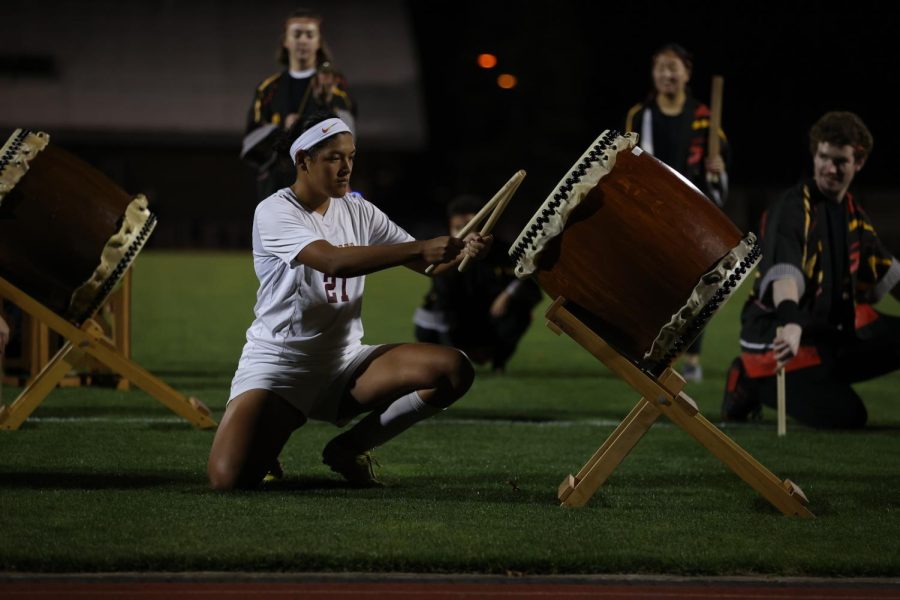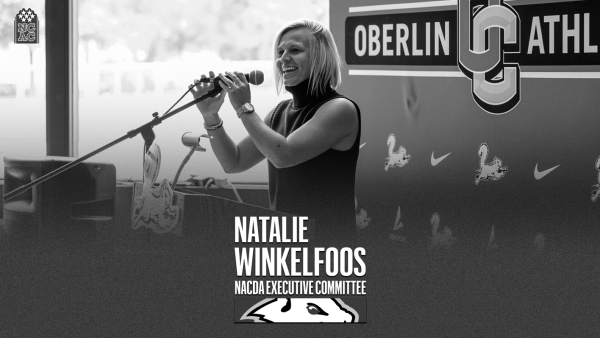Taiko Narrates Artistry Through Athleticism
Adrienne Sato performs during the women’s soccer game against Denison University during Homecoming Weekend.
Editor’s note: Both authors are members of Oberlin College Taiko, with Sato serving as co-chair. All interviewees are current members.
On a cold Wednesday night in October, 12 Oberlin students, dressed in various forms of athletic attire, circle around in the dusty basement of First United Methodist Church. After a few minutes of chattering about their week, classes, and favorite kinds of soup, one of them looks around the circle and asks, “Ready?”
The group proceeds to complete a plethora of jumping jacks, arm circles, push-ups, planks, and Russian twists. It’s important for the students to be prepared, as this is one of three two-and-a-half hour weekly practices required to excel at their craft. However, they aren’t getting their bodies prepared for a sport, but rather to rehearse for an upcoming show as members of Oberlin College Taiko.
A style of Japanese drumming, taiko combines aspects of dance, music, martial arts, and theater. It has evolved into an art form, a pathway for self expression, and, what may be surprising to some, a type of athleticism.
Before an actual taiko practice can begin, 12 drums, approximately 30 pounds each, need to be brought down from a storage closet to the basement, carried precariously down three narrow flights of stairs. In order to hit the drums, players need to stay in a lunge position for the entirety of the piece, gripping wooden bachi, or drumsticks. Bachi are held in various positions such as overhead, at a 45-degree angle, or even with both arms making counterclockwise circles.
Different pieces can require even more extreme positions. O-daiko, a drum the size of a hay bale, has players consistently raising their arms above their heads in order to hit the drum with incredible amounts of force. To play “Tatsumaki,” players must switch between 90-degree side lunges for six minutes of the rapid-fire song. And the notoriously challenging “Yatai” requires players to go from laying on the ground to the curl up position multiple times.
Harper Ross, OC ’22, noted the unexpected physical demand taiko had on them.
“When you start learning how to stand properly in taiko, it’s kind of like doing an extended wall sit for hours each weekend,” Ross said. “It definitely adds up … I know for me personally, the shape that I’m in at the beginning of the semester is vastly different than the shape I’m in at the end of the semester.”
In addition to physicality, players must tell a story through their movement just like dancers narrate with their bodies. Taiko pieces are stories of time, identity, celebration, and change. For instance, “Noon” has players raise both hands up at the end of the piece to signify the hour and minute hand on the clock, and “Matsuri,” a festival piece, slowly builds up tempo, with everyone joyfully shouting “Matsuri Daiko!” before the speed-up. Every song features kiais, various shouts that build energy and demonstrate power.
College second-year Bennett Elder commented on how fitness is required to narrate such stories with care.
“You have to produce a sound that really reverberates,” he said. “[There’s] really dramatic and energetic movements that you try to make as graceful as possible, [really emphasized by] the shape that our arms trace.”
OCT also has a history of supporting Oberlin athletes. So far, the group has performed at two athletics events this year: the women’s soccer game against Denison University on Homecoming Weekend and the cross country Inter-Regional Rumble. For both performances, OCT played various songs and backbeats to motivate players and excite the crowd.
College fourth-year Megan Reilly, who also serves as an OCT co-chair and co-instructor for the Introduction to Taiko ExCo, said that the Rumble specifically was a memorable experience and hopes to perform more for athletics in the future.
“There’s a lot more interaction with the crowd because the runners can come up to you and talk to you about it,” Reilly said. “It’s a lot less formal, but also a lot more rewarding in that we’re doing something impactful for them. … It’s a lot of fun to feed off of the energy of the players and the crowd and just do whatever comes to mind that we think would hype everyone up.”
Taiko is an extreme example of music overlapping with athletics because of the dedication, memory, and physical and mental demands required. For College second-year Ollie Elgison, finding the delicate balance between the two is something that makes taiko invaluable to them.
“I’ve never really considered myself an athletic person,” they said. “I’ve tried a bunch of different sports, and I’ve just never really enjoyed any of them that much. … I feel like something almost clicked when I did [taiko] … Putting that movement into sound and making it something productive is kind of the thing that I was missing from the different sports and something that formed meaning for me.”
Because of the disparate aspects it embodies, taiko itself has a bit of an identity crisis. Not included as a club sport or in traditional Conservatory pedagogy, it’s hard to sort it into one group and define its players. For instance, Elder noted that while taiko is a physically taxing activity, he does not consider himself to be an athlete.
“I would say [I’m] more of a performer because performance is still a term that encompasses activity and athleticism,” he said. “But I feel that [the term] performer connects more with the idea of art.”
Additionally, taiko has been historically reported in the Arts & Culture Section of the Review, whether that be about involvement through Colors of Rhythm or Asian Night Market. While this coverage is important, physical movement and strength is also an integral yet underrepresented component of taiko. Taiko’s relationship to athleticism can give insight into how we define an athlete or artist and the subjectivity behind those terms.








